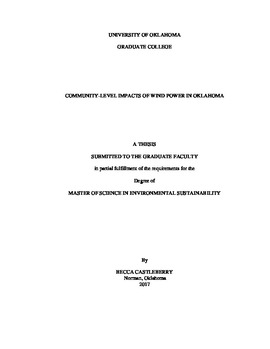| dc.contributor.advisor | Greene, John | |
| dc.contributor.author | Castleberry, Becca | |
| dc.date.accessioned | 2017-05-23T17:20:04Z | |
| dc.date.available | 2017-05-23T17:20:04Z | |
| dc.date.issued | 2017-08 | |
| dc.identifier.uri | https://hdl.handle.net/11244/50905 | |
| dc.description.abstract | Wind power development in Oklahoma has expanded rapidly in the past decade, going from no installed capacity to producing over 20 percent of the state’s energy. Given the industry’s rapid development, there has been mixed social and political acceptance within the state, with some residents showing strong support for wind turbines while others are concerned with potential effects upon health or property values from living near turbines. This research provides two case studies for the impact of utility-scale wind farms in western Oklahoma. The first case study focuses on the relationship between the wind turbines and property values in five Oklahoma counties. Sales prices of single-family homes and unplatted land were examined in relation to their distance away from wind farm construction. This effort used both multivariate statistics and hedonic pricing analysis to examine these relationships. A second analysis of the local impact of wind farms was undertaken through a spatial and statistical analysis of characteristics of public school districts with and without turbines, as public schools in Oklahoma receive approximately 30 percent of their funding from property taxes. Aspects of public school districts that were analyzed include percentage of revenue from local and county sources, student-teacher ratios, and per-student expenditures. Results show that, counter to some of the more sensationalist claims, there have been no significant decreases in sales prices in homes near wind farms in the study area. Similar results were found with the analysis of the unplatted parcels. The results from the school district analysis shows that those districts that contain wind farms have a greater percentage of revenue from local and county sources, suggesting they are less susceptible to changes in funding from state and federal sources. Furthermore, the increased local revenue stream for districts with wind turbines allows state funds to be distributed to school districts without a strong local tax base. | en_US |
| dc.language | en_US | en_US |
| dc.subject | Wind power, Real Estate, Public Schools, Oklahoma | en_US |
| dc.title | Community-Level Impacts of Wind Power in Oklahoma | en_US |
| dc.contributor.committeeMember | Gliedt, Travis | |
| dc.contributor.committeeMember | Meo, Mark | |
| dc.date.manuscript | 2017-05-23 | |
| dc.thesis.degree | Master of Science in Environmental Sustainability | en_US |
| ou.group | College of Atmospheric & Geographic Sciences::Department of Geography and Environmental Sustainability | en_US |
